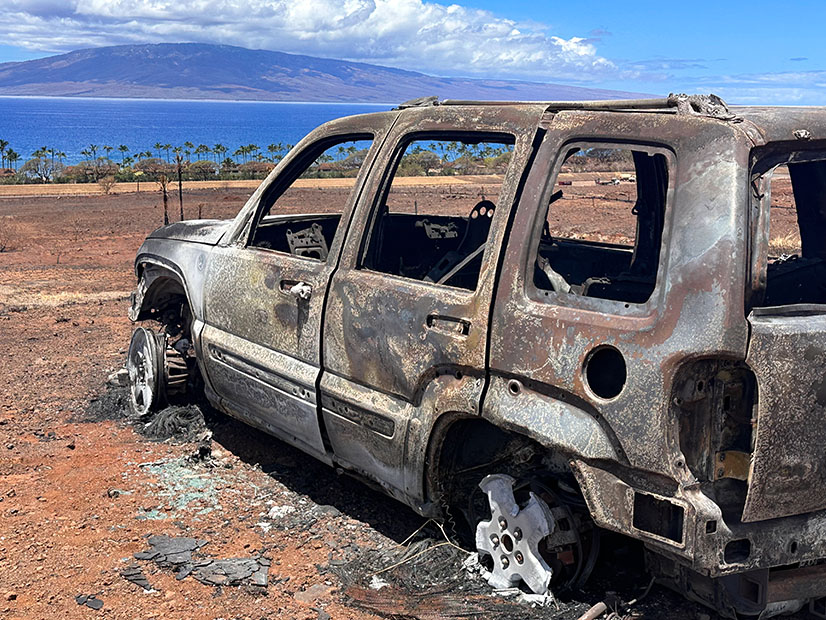
A lawsuit filed last Thursday on behalf of shareholders in Hawaiian Electric Industries, the parent company of Hawaiian Electric Co. (HECO), accuses the company of ignoring opportunities for actions that could have prevented this month’s deadly wildfires on the island of Maui.
The suit, filed in the U.S. District Court for Northern California by the Pomerantz Law Firm and seeking class-action status, is one of several the utility is facing related to the wildfires. At least three more lawsuits were filed in Hawaii this month, two of which also seek class-action status on behalf of residents of Maui. In addition, Maui County also announced Thursday that it had filed suit against Hawaiian Electric and its subsidiaries for “failing to power down their electrical equipment” in spite of wildfire warnings.
The wildfires have killed 115 people and burned more than 3,000 acres of Maui, according to the latest update from Maui County, including the historic town of Lahaina, which the county’s lawsuit says was left in “utter devastation.” As of Tuesday, the Lahaina and Kula fires — which began Aug. 8 at 6:37 a.m. and 11:30 a.m., respectively — were 90% contained, while the Olinda fire, which started Aug. 7 at 10:47 p.m., was 85% contained.
Citing the Pacific Disaster Center and the Federal Emergency Management Agency, Maui County estimated that rebuilding from the Lahaina fire alone would cost at least $5.5 billion.
Maui’s lawsuit accuses Hawaiian Electric of negligence in failing to power down its power lines and other electric equipment despite a red flag warning from the National Weather Service on Aug. 7 indicating an increased risk of fire danger. The county further alleged that NWS warned the state of Hawaii in general, and Hawaiian Electric’s subsidiaries Maui Electric (MECO) and HECO specifically, days in advance of the ignition that high winds could knock down power lines and that fires could spread quickly in the dry conditions.
“Had defendants heeded the NWS warnings and de-energized their power lines during the predicted high-wind gusts, this destruction could have been avoided,” the complaint said.
In addition to the utility’s alleged inaction on the days the wildfires began, Maui County claims Hawaiian Electric and its subsidiaries neglected their duties to “properly maintain and repair” their utility poles and other electrical equipment, and to “keep vegetation properly trimmed and maintained” to prevent contact with power lines. The county’s complaint cites multiple state and national statutes and regulations it says the utilities did not follow (although not NERC reliability standards, with which Hawaiian utilities are not required to comply).
Maui County also said that even before the fire, many of HECO and MECO’s wooden utility poles on Maui “were severely deteriorated and damaged by advanced wood decay [that] caused and/or contributed to” their failure, and that the defendants should have known the above-ground transmission lines “posed a significant fire hazard.”
The class-action suit filed in California also accuses Hawaiian Electric of neglecting its duties before the fires but focuses on its alleged misdirection of shareholders in the preceding months and years. Plaintiffs in the suit claim to have suffered “significant losses and damages” due to the “precipitous decline in the market value of the company’s securities” following the fires and media reporting on allegations of the utility’s unpreparedness.
Hawaiian Calls Accusations “Irresponsible”
Hawaiian Electric responded to the Maui County lawsuit in a media statement Thursday, labeling the complaint “factually and legally irresponsible” and warning that the county might “leave us no choice in the legal system but to show its responsibility for what happened that day.” It has not commented publicly on the other lawsuits; a representative declined to comment.
The utility pushed back on some of the county’s claims, noting that while the fire that began in Lahaina the morning of Aug. 8 apparently was caused by fallen power lines, the Maui County Fire Department reported the fire “100% contained” and later “extinguished.” Although a second fire began in the same area around 3 p.m., Hawaiian Electric observed that all its power lines in the area had been de-energized for more than six hours at that point. It also mentioned that its own crews reported the afternoon fire to firefighters.
Hawaiian Electric did not mention the Kula and Olinda fires in its response, nor did it comment on the allegations of improper maintenance.
“The county’s lawsuit distracts from the important work that needs to be done for the people of Lahaina and Maui,” said Hawaiian Electric CEO Scott Seu. “Since the devastating fire in Lahaina, Hawaiian Electric’s focus has been supporting all of those who have been impacted and helping Maui recover. HEI stands with Hawaiian Electric and the community in rebuilding Lahaina and empowering a thriving future for Maui and the other islands we serve.”

